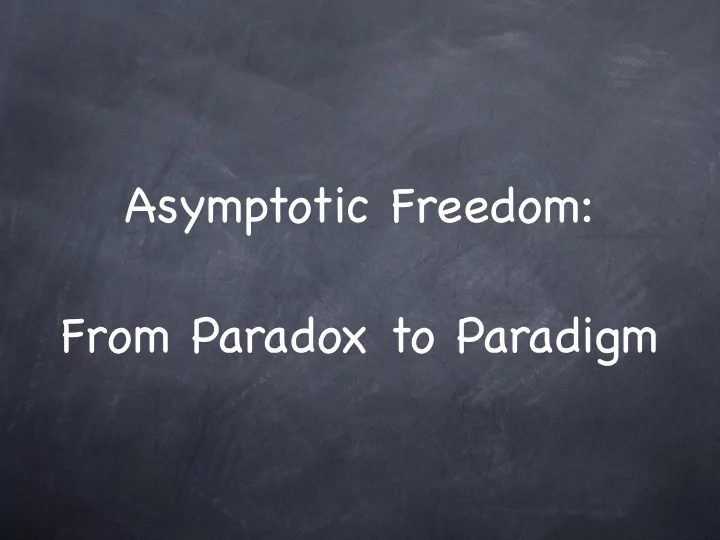

Asymptotic Freedom: From Paradox to Paradigm
Paradox 1: Quarks are Born Free, But Everywhere They are in Chains
The quark model “works” ...
... but its rules are very strange. Quarks behave independently when they’re close, but they can’t be pulled apart. An unprecedented hypothesis: CONFINEMENT! Hard-hit quarks accelerate rapidly, without radiating away energy. The strongest force of nature “turns off”: FREEDOM!
Paradox 2: Quantum Mechanics and Special Relativity Both Work
Special relativity puts space and time on the same footing, but quantum mechanics treats them very differently. This leads to a creative tension ...
Dirac: from uncertainty to antiparticles Feynman-Schwinger-Tomonoga: the reality of virtual particles (QED) ‘tHooft-Veltman: the vast scope of virtual particles (electroweak gauge theory)
Landau’ s Paradox Screening by virtual particles wipes out interactions The demise of quantum field theory was widely proclaimed - and welcomed!
Paradox Lost: Asymptotic Freedom
Some very special quantum field theories have anti -screening (asymptotic freedom). One of these theories is uniquely well suited to accommodating quarks. It predicts gluons. This is quantum chromodynamics (QCD).
Antiscreening explains how the same basic interaction can appear either powerful or feeble, depending on circumstances. The interaction is feeble at small separations, powerful at large separations. (Confinement!) The interaction does not interfere with violent deflections. (Freedom!) Nor does it induce them.
Paradigm 1: The Hard Reality of Quarks and Gluons
Paradigm 2: Mass Comes From Energy
Einstein’ s Second Law: m=E/c 2
CP-PACS (1998) 1.8 GF11 (1993) experiment 1.6 & 1.4 $ $ * m had ! # 1.2 # * [GeV] " % 1 0.8 K* N 0.6 K quenched QCD 0.4
Paradigm 3: The Early Universe Is Simple
Paradigm 4: Symmetry Rules
Gravity fits too! (roughly)
Frontiers of Symmetry Unification ! Proton Decay, Supersymmetry Supersymmetry ! World x2, Dark Matter QCD T-protection ! Axions, Dark Matter Gauge Symmetry Breaking ! Higgs sector
The Greatest Lesson If we work to understand, then we can understand.
Credits hadron tables: Particle Data Group jet event: L3 collaboration running coupling plot: S. Bethke pion fields: G. Kilcup QCD “lava lamp”: D. Leinweber little bang: STAR collaboration technical assistance: C. Suggs
Recommend
More recommend